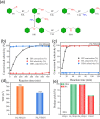Tuning the selectivity of catalytic nitriles hydrogenation by structure regulation in atomically dispersed Pd catalysts
- PMID: 34702832
- PMCID: PMC8548558
- DOI: 10.1038/s41467-021-26542-y
Tuning the selectivity of catalytic nitriles hydrogenation by structure regulation in atomically dispersed Pd catalysts
Abstract
The product selectivity in catalytic hydrogenation of nitriles is strongly correlated with the structure of the catalyst. In this work, two types of atomically dispersed Pd species stabilized on the defect-rich nanodiamond-graphene (ND@G) hybrid support: single Pd atoms (Pd1/ND@G) and fully exposed Pd clusters with average three Pd atoms (Pdn/ND@G), were fabricated. The two catalysts show distinct difference in the catalytic transfer hydrogenation of nitriles. The Pd1/ND@G catalyst preferentially generates secondary amines (Turnover frequency (TOF@333 K 709 h-1, selectivity >98%), while the Pdn/ND@G catalyst exhibits high selectivity towards primary amines (TOF@313 K 543 h-1, selectivity >98%) under mild reaction conditions. Detailed characterizations and density functional theory (DFT) calculations show that the structure of atomically dispersed Pd catalysts governs the dissociative adsorption pattern of H2 and also the hydrogenation pathway of the benzylideneimine (BI) intermediate, resulting in different product selectivity over Pd1/ND@G and Pdn/ND@G, respectively. The structure-performance relationship established over atomically dispersed Pd catalysts provides valuable insights for designing catalysts with tunable selectivity.
© 2021. The Author(s).
Conflict of interest statement
The authors declare no competing interests.
Figures




References
-
- Salvatore RN, Yoon CH, Jung KW. Synthesis of secondary amines. Tetrahedron Lett. 2001;57:7785–7811. doi: 10.1016/S0040-4020(01)00722-0. - DOI
Grants and funding
LinkOut - more resources
Full Text Sources

